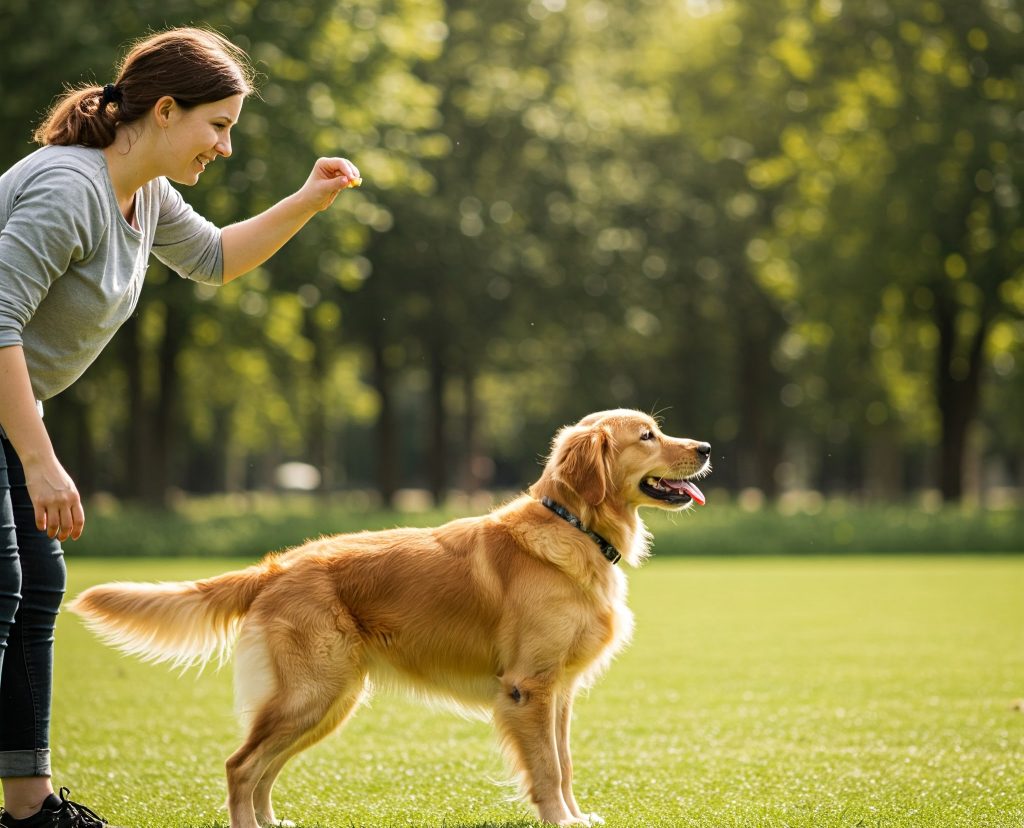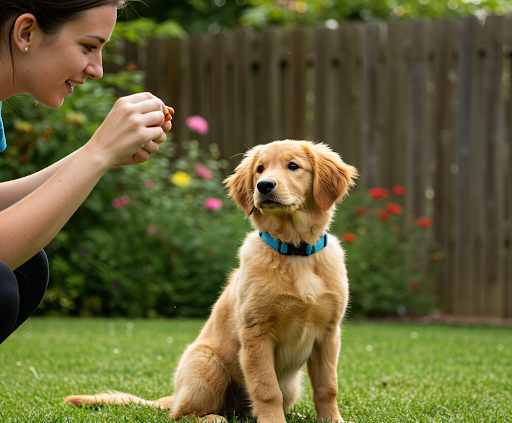Ready to teach your dog some life skills?
Alright, let’s cut to the chase. Training your dog doesn’t have to be boring or feel like a chore. Change perspectives and think of it as unlocking their inner genius, all while leveling up your connection. No matter if you’ve got a tiny troublemaker or a seasoned sidekick, you can easily nail a few key commands and change the game for both of you.
From making life smoother to keeping your dog safe, these are must-learn skills that can turn into the foundation for even more advanced tricks and a deeper bond. Ready to turn your pup into the star student of the dog park?

Let’s see five of the easiest and most important commands every dog should know.
1. Sit command
This one is foundational for dog training, as it’s essential for teaching dogs discipline and control. It encourages them to be still, and it’s usually the first command that puppies learn. It’s a building block for good behavior and a starter for other commands.
Step-by-step training
Your dog should be in a standing position. Hold a treat near his nose, just above the line of its eyes. The visual and scent will capture their attention. Guide the movement of the treat upwards towards their forehead, so they naturally lower their body in a sitting position. This is an action that mimics their natural response of focusing on the treat.
When their bottom touches the floor, you can offer the treat as a reward to help reinforce action. Introduce a verbal cue like “Sit” while you guide the dog into position. It will help them associate this word with the action.
If your dog is distracted, make sure you practice in a place that is quiet and familiar before increasing the level of distractions. Be patient, as some dogs take longer to learn the sit command, especially if they are untrained or energetic. Encouragement and patience are the keys to success.
The sit command is crucial for managing your dog’s behavior in situations that require them to be calm and controlled, like at a vet visit, on walks, or during social interactions with both people and other dogs.

2. Stand command
Designed to teach your dog to keep an upright position, The Stand Command is helpful during grooming sessions or if you need your dog to stay while you clean or inspect their paws, ears, or fur, but also for situations such as veterinary exams.
Step-by-step training
You should start with your dog in a sitting position when they are already somewhat calm and focused.
Hold a treat near their nose, catching their attention. Move it slowly in a forward movement, encouraging the dog to rise to a standing position. Guide the treat slightly upward to address the dog to stand rather than lean forward.
Immediately give them the treat as a reward once they stand up to reinforce the positive behavior. When your dog starts to stand consistently with the treat, use a verbal cue like “stand” to help them associate the verbal command with the action.
After many successful repetitions, try the command without a treat, and you can even use a hand gesture to prompt your pup or just the verbal cue alone. However, reward them once they successfully stand.
Challenges in this command reside in the fact that some DGs can get confused if they follow the treat too quickly, and they might attempt to jump instead of stand. It’s important to guide them gently in the position you want.
If your dog is distracted, he may not focus on your directions, so choose a quiet area before introducing them in places with other pets or noise.
The Stand command brings more control over your dog’s movements, especially in situations requiring them to be in an upright position or stationary, making managing their behavior a lot more effective.
3. Stay Command
This one is crucial for teaching your dog patience, and it offers him the ability to remain calm in one spot for a specific amount of time. It’s important for situations when you need your dog to stay in place, like when guests arrive or during walks and emergency situations.
Step-by-step training
Start with your dog in a sitting position. Hold your hand in front of them with the palm facing them and make a “stop” gesture. Say “stay” calmly and firmly. Signaling that they should remain in place. Reward their stillness, and at first only ask them to stay in place for a few seconds. Start again, and if they move, gently guide them back into position and ask them to stay again. Reward them again.
It’s important to increase the length of time slowly the dog is expected to stay in place and be patient as they learn.
After they learn to stay for several seconds, move further away while giving them the Stay command. This helps them learn that they should stay still even if you’re not right next to them.
Teach them a release word, like “okay,” or any verbal cue that lets them know they can stop staying and can move again. This brings them clarity about when they are no longer expected to remain in position.
The Stay command is incredibly important for safety in situations like crossing the street or preventing them from getting into potentially dangerous situations. Training your dog the Stay command provides them discipline and the ability to remain calm around distractions, so they can adapt to various environments.

4. Come Command
The Come command is also very important, ensuring your dog’s control and safety in many situations. It teaches your dog to return when called, so when you need to catch their attention quickly, they will know to be back.
Step-by-step training
Begin with your dog on a leash in a familiar area. You should start at a short distance and make sure you have their full attention.
You can hold treats in your hand to encourage your dog to come and use the treat as a lure to get them moving toward you. When your dog starts to move toward you, use the word “come” enthusiastically. The tone of your voice will convey excitement and encouragement, motivating them to move toward you.
As soon as your pup reaches you, reward them and offer praise. This reinforcement helps them connect with the action. Once your dog consistently comes when called, gradually increase the distance. Continue to use the treat as a lure and reward them when they come to you.
It’s important to practice in different environments, increasing the distractions. Don’t scold your dog when they don’t come or if they take long to respond. Keep in mind that you want them to associate coming to you with a positive experience, not punishment or fear.
5. Heel Command
The heel command is useful for walks, especially in busy and crowded areas, ensuring your pup doesn’t pull or veer off in different places. It creates a calm walking experience for both of you, reducing distractions and getting into trouble.
Step-by-step training
Start with your dog on a leash, standing next to you on the side you want to have them walk. It’s important to start in an area with minimal distractions.
Hold a treat on their nose level and move it slightly forward to the side of you, encouraging them to walk along with you.
Walk slowly while holding the treat in your hand, and as you move forward, guide them with the leash and reward them when they stay in position.
As your pup walks calmly by your side, introduce the verbal cue: something like “Heel” in a calm and firm voice. When they stay by your side, walking at a calm pace, reward them with a treat and praise. This will encourage them to continue walking at your pace.
Gradually increase the walking pace and reward them for staying by your side. If they begin to pull ahead, gently tug on the leash, guiding them back into position and reinforcing the “Heel” command.
Once they consistently heel in quiet environments, you can practice in areas with more distractions, like busy streets or parks, helping them to stay focused while walking.
With the heel command, your dog can enjoy walks without the stress of pulling or tugging, creating an enjoyable experience for both of you.
Have you heard about PetDroid Interactive Dog Ball? It moves and rotates for 25 seconds, then stops for 5 seconds, repeating this cycle for a total of 2 minutes before entering standby mode. You can find it on Amazon and keep your dog entertained.
Read next: Pet First Aid – Essential Steps Before Reaching the Vet












